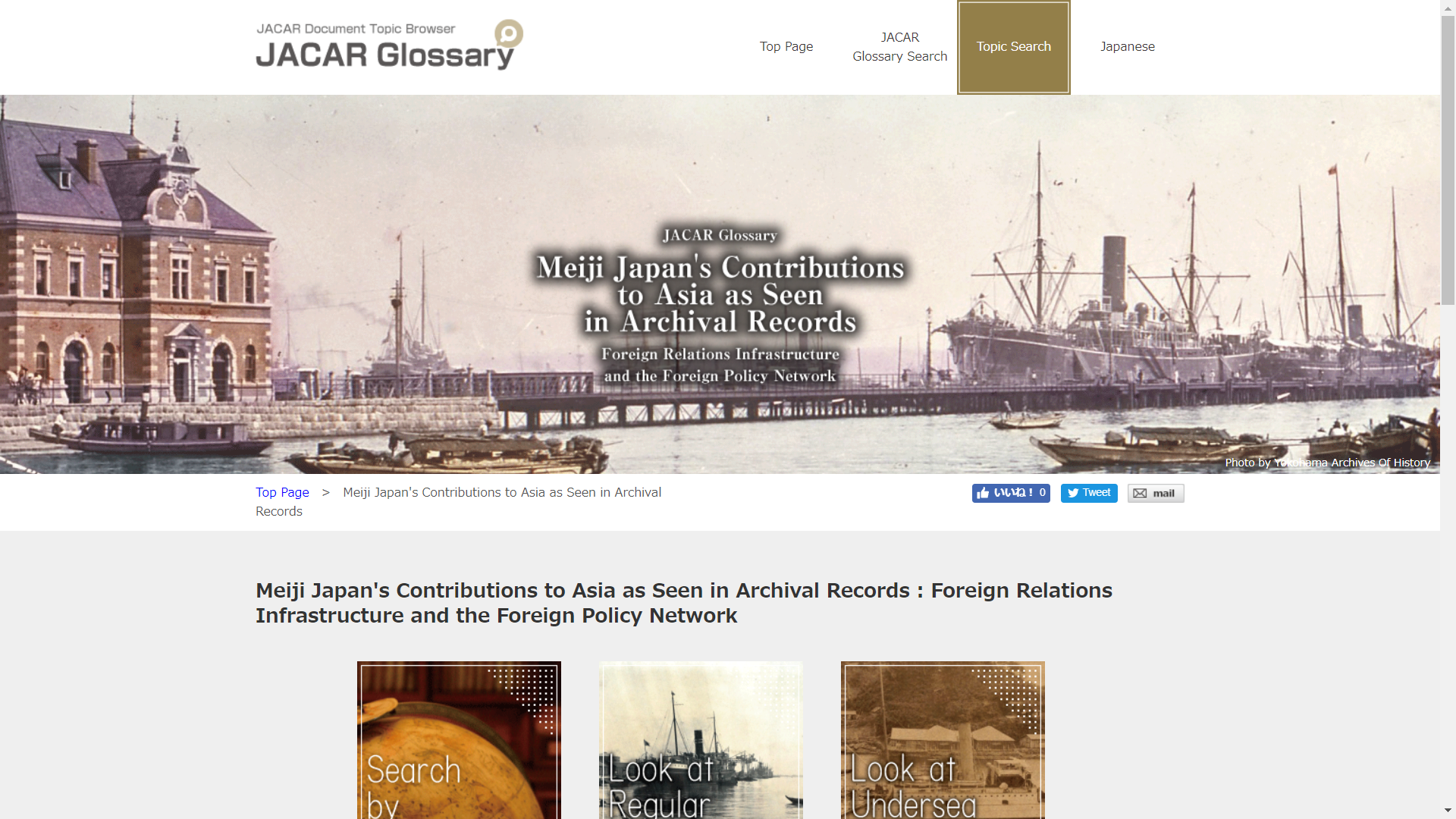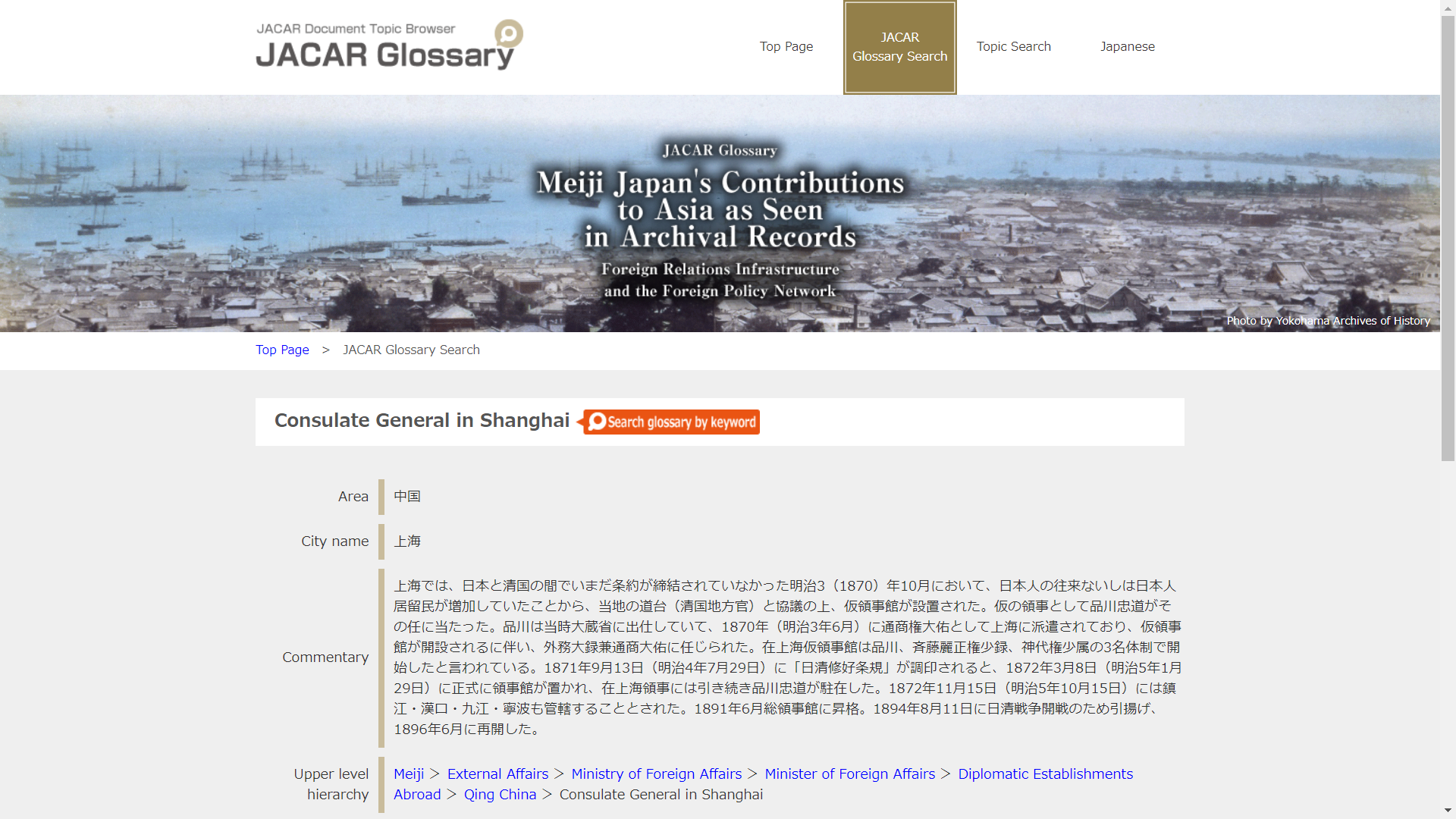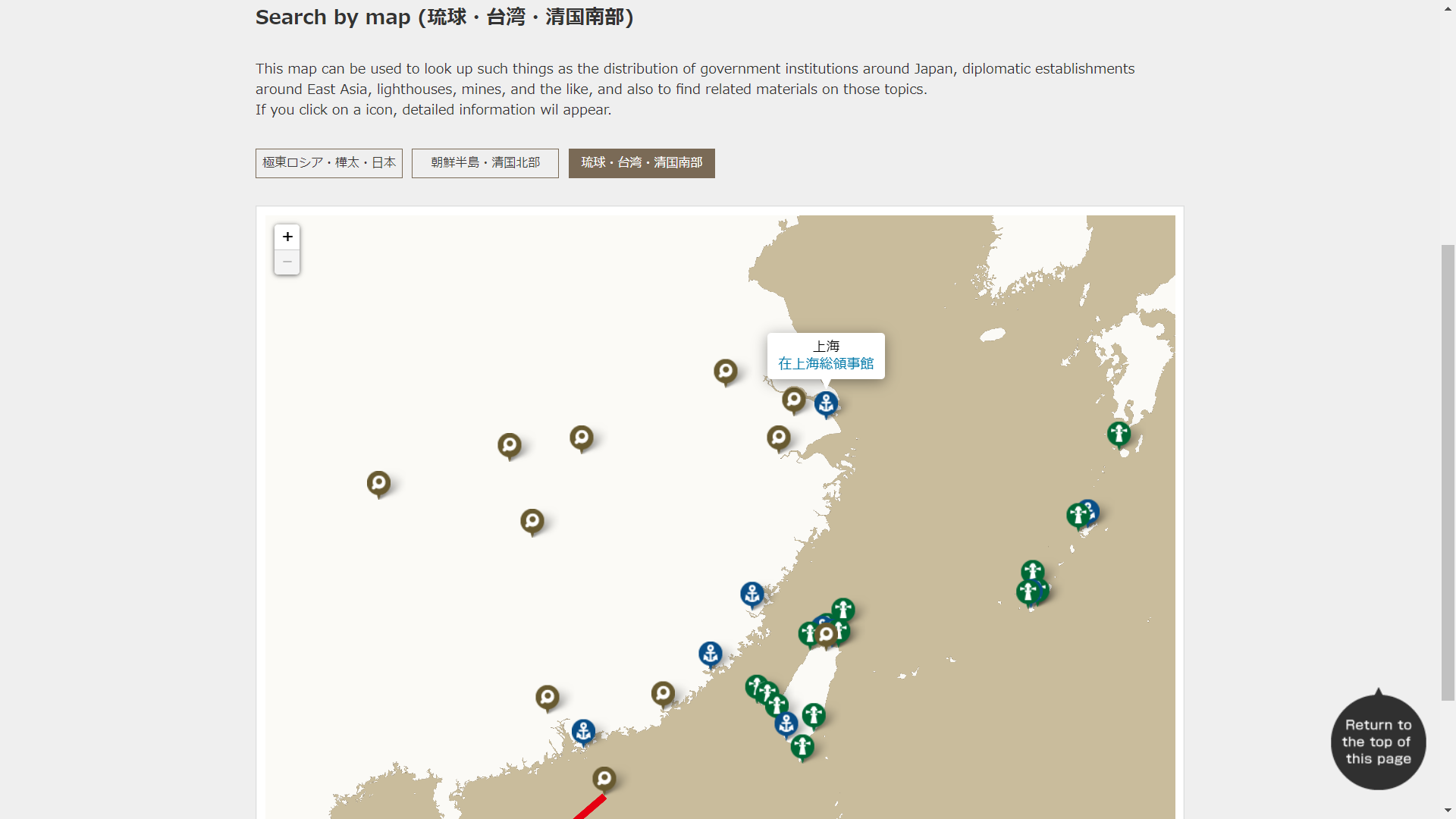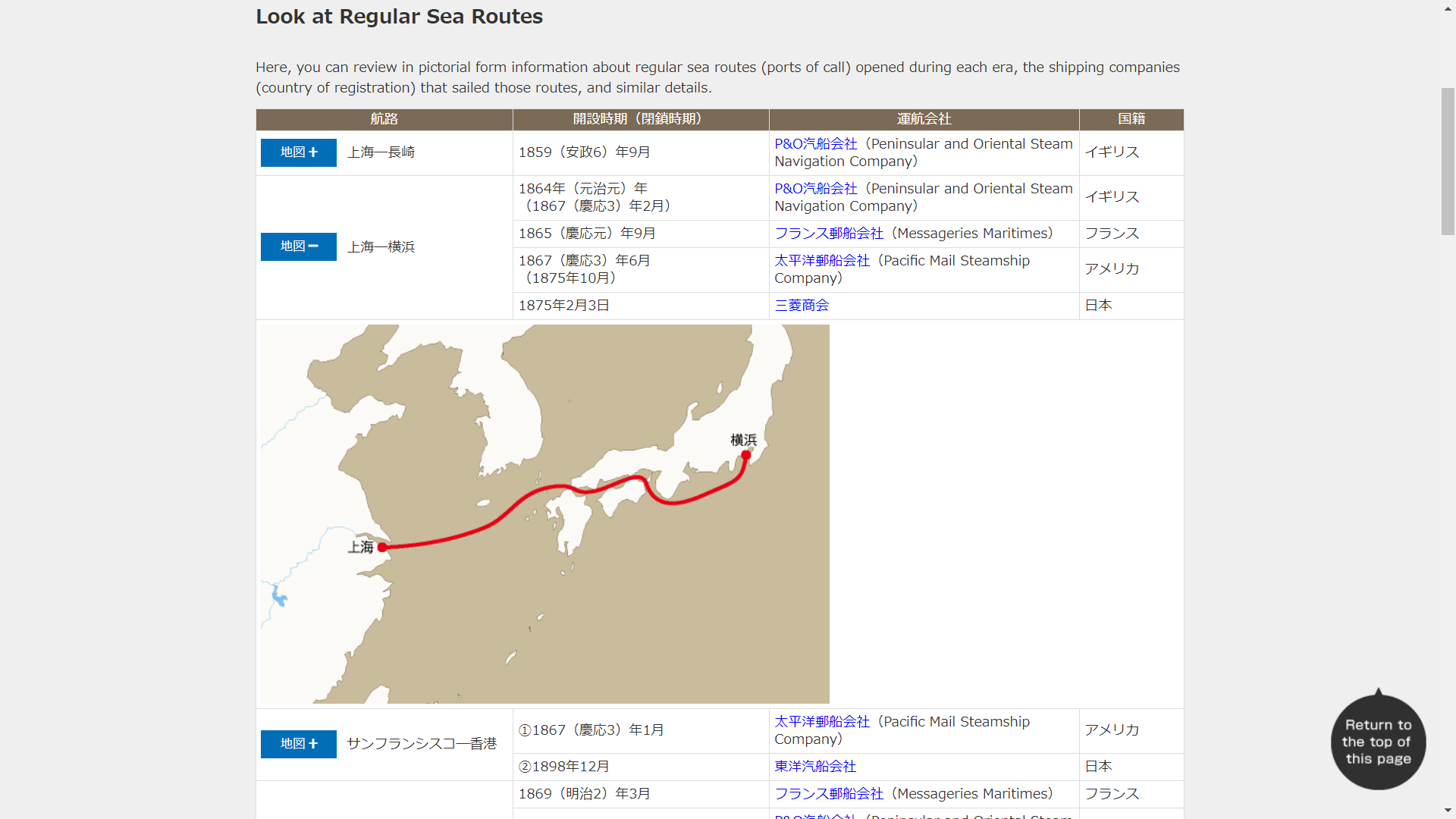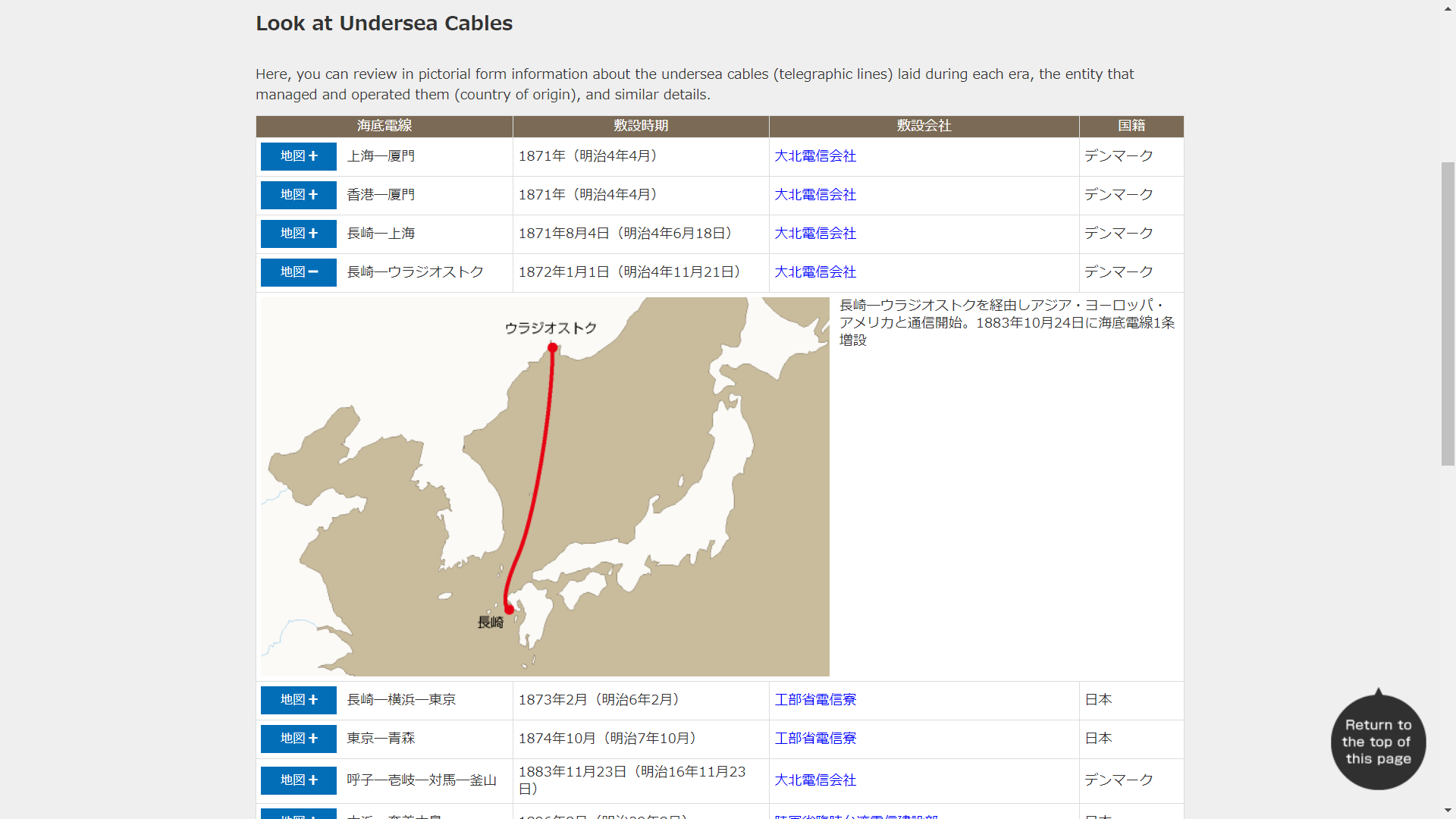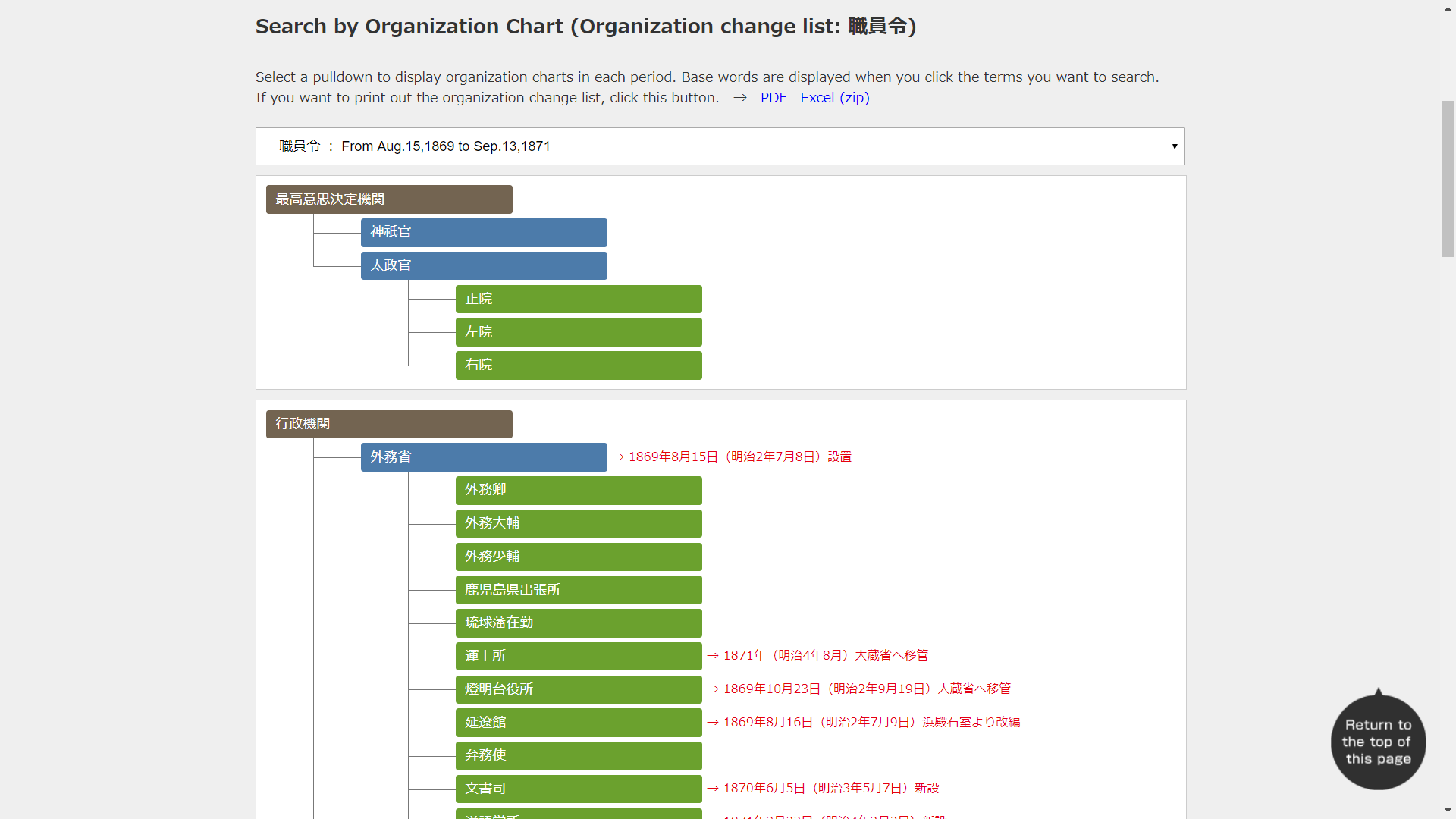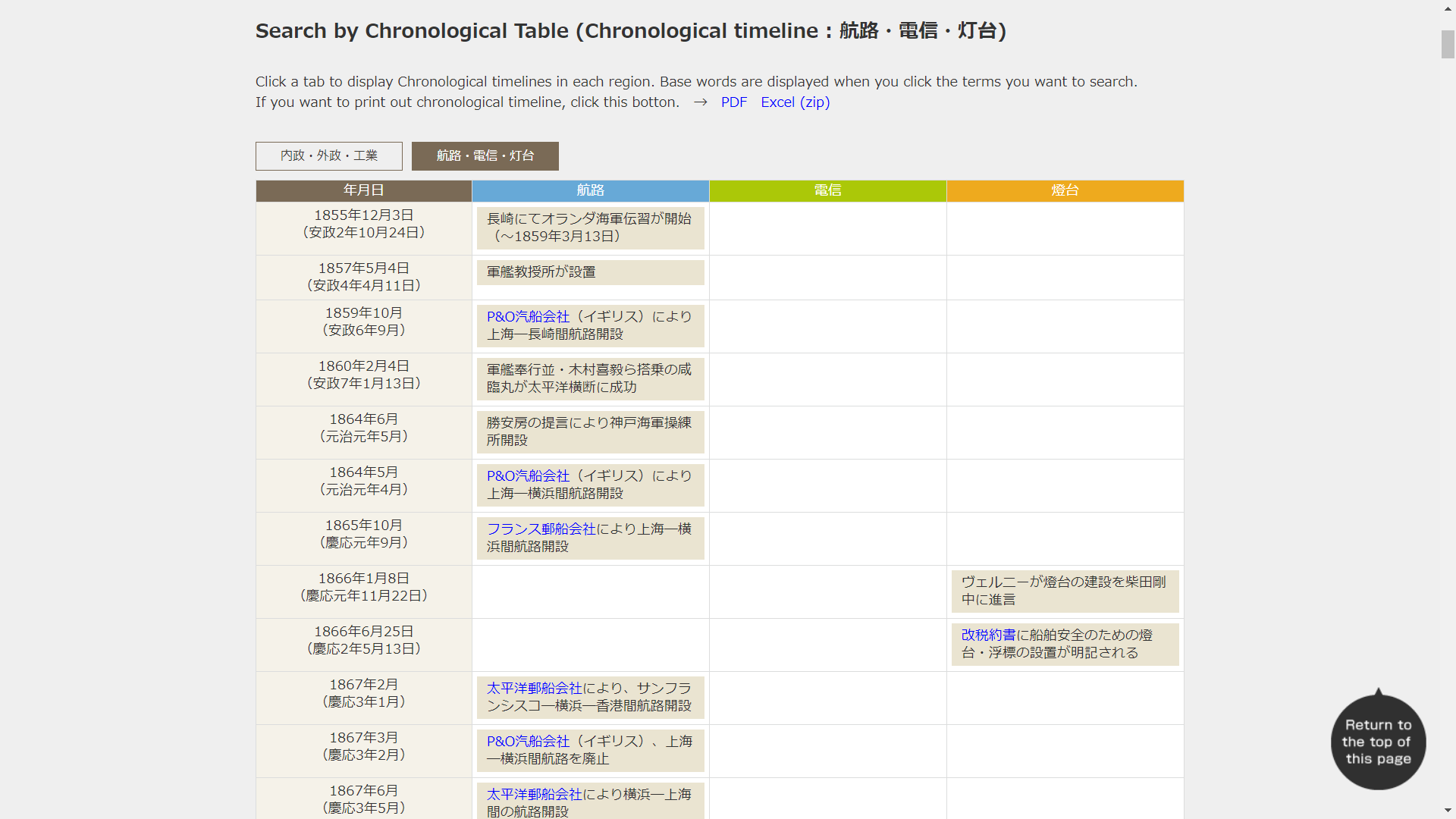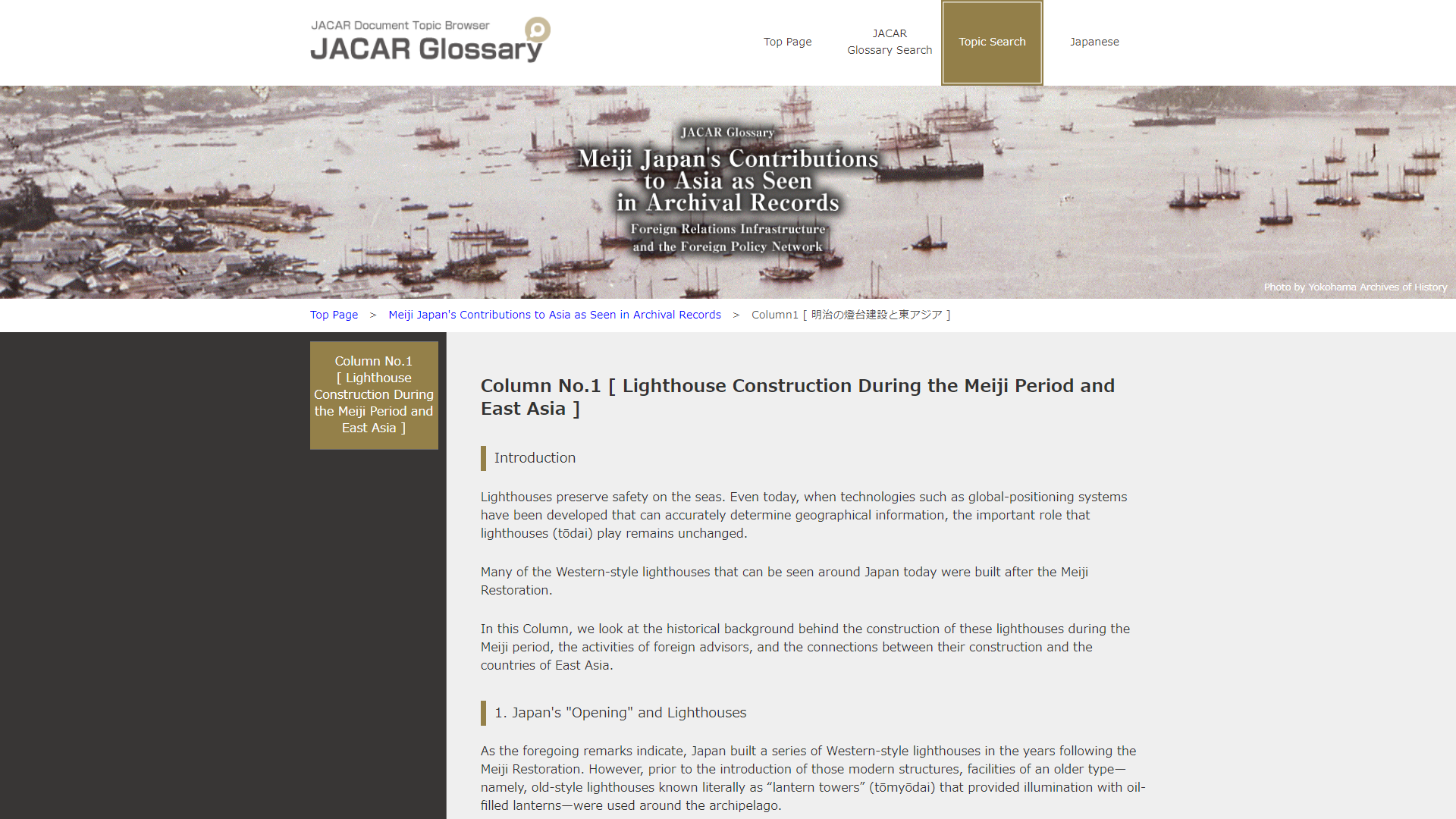

-Documents released on March 11, 2019
-Documents released on March 28, 2019
-Documents released on March 29, 2019
2. Documents Spotlight
-Manchukuo’s International Relations: Manchukuo-Recognition Problem and Foreign Missions(Taikan Oono, Researcher, JACAR)
3. Introduction of New Contents
-Special web exhibition “Meiji Japan's Contributions to Asia as Seen in Archival Records”
4. Information on Related Document Holdings
-U.S. / India / Poland
5. Outreach Activities
6. Event Informations on the Related Organs
-National Archives of Japan
- Category 2 The United Nations > Section 3 ECOSOC, Specialized Organizations >Item 2 Industry and Trade;
- Category 2 The United Nations > Section 3 ECOSOC, Specialized Organizations >Item 3 Traffic, Communications and Weather;
- Category 2 The United Nations > Section 3 ECOSOC, Specialized Organizations >Item 4 Art, Science, Culture and Religion;
- Category 2 The United Nations > Section 3 ECOSOC, Specialized Organizations >Item 5 Hygiene, Health and Drugs;
- Category 2 The United Nations > Section 3 ECOSOC, Specialized Organizations >Item 6 Society, Labor and Human Rights
As part of our on-going mission to preserve important historical documents for future generations, Ōita University Library and the JACAR would like to announce the availability of a new on-line database. We have digitized approximately 8,400 items which were collected between 1925 and 1945 by the Ōita College of Commerce and Ōita College of Economics, the two predecessor institutions to today’s Ōita University Faculty of Economics.
This collection spanning the fields of industry and economics can be described as a unique treasure-trove of information. It includes documents and materials published by the Japanese government (for domestic purposes) as well as institutions with connections to Japan’s former empire such as the government of Manchukuo, the Governor-General of Korea, the Governor-General of Taiwan, local chambers of commerce, and enterprises doing business in the colonies. The materials have been catalogued into 12 region-based categories: General Issues and Japan, Taiwan, Korea, East Asia, Manchuria/Kwantung, China, South Seas, Thailand, Russia, United States of America, and International.
On September 18, 1931, Japan’s Kantō-Gun (Kwantung Army) staged what would come to be known as the Mukden or the Manchurian Incident. Following months of conflict to take control of the region, on March 1, 1932, the country of “Manchukuo” was established that, it was argued to foreign powers, was an independent state. As is well known, the following year on February 24, 1933, the Japanese representative to the League of Nations Matsuoka Yosuke would walk out of that body’s General Assembly meeting and his country would subsequently withdraw from the League after the Assembly voted to reject the legitimacy of Manchukuo as an independent state.
Today, Manchukuo’s status as a Japanese "puppet state" is an established one. In China, they use a character that means “false” (偽) to refer to that puppet aspect, leading it to be spoken of as “false country of Manchuria” (wei-Manzhouguo or wei-Man). However, all of this is not to say that Manchukuo had an existence at the time that was completely distanced from the international community. While they were limited, there were some other countries which Manchukuo had diplomatic relations. By the time Manchukuo was dissolved with the Japanese loss that ended World War II, a number of these countries had established embassies in the puppet state.
Manchukuo’s diplomacy is thought of as having been controlled by Japan, and for that reason many of the texts connected to Manchukuo’s interactions with other countries and the establishment of diplomatic missions in other countries have come to be included among the files of Japan’s Ministry of Foreign Affairs (MOFA). In this article, I want to use primarily documents included in the Prewar Diplomatic Records provided by MOFA’s Diplomatic Archives to talk about why and how various foreign missions were established in Manchukuo.
In the wake of the Manchurian Incident, the League of Nations dispatched a commision led by Victor Bulwer-Lytton to investigate the lawfulness of the Japanese military action. On September 15, 1932, immediately prior to the Lytton Report’s release, Japan concluded the Japan-Manchukuo Protocol with that entity and became the first state to recognize Manchukuo.
After the League’s General Assembly declined to recognize Manchukuo as an independent state, it was believed that the Vatican became the first state other than Japan to acknowledge Manchukuo. On February 20, 1934, the Holy See appointed its Bishop Auguste Ernest Pierre Gaspais resident in Jilin Province, China, to be its representative in Manchukuo. Gaspais conveyed word of this appointment in a letter he sent that April 18 to Manchukuo Foreign Affairs Minister Xie Jieshi. (*note1) [IMAGE 1]
Catholic missions had been active in Manchuria since before the Manchurian Incident, and came under the jurisdiction of the Apostolic Vicariate of Beiping (another name used at one time for Beijing). However, with establishment of Manchukuo the Vatican decided to make it a separate diocese from China and put it under Bishop Gaspais’ jurisdiction.(*note2) With this act, some saw this as the Vatican’s having extended de facto recognition to Manchukuo, and at the time some in Japan even spoke of it as “religious recognition.”(*note3) However, the Vatican never sent any diplomatic envoys to Manchuria, nor did it establish a foreign mission there. There are many interpretations of why the Vatican took the measures it did. Among them, it is thought that it saw the possibility that Manchukuo could serve as a fortress against communist forces that would protect Catholics in Manchukuo.(*note4)
Following the Vatican, it was El Salvador, the Central American country, who recognized Manchukuo. El Salvador’s Consul General in Japan Leon Siguenza notified the government and recognized of Manchukuo on March 3, 1934. On May 19, the same year, Siguenza conveyed to the Manchukuo envoy in Japan Ding Shiyuan that the relationship between the two countries for “commercial relations set up in the future should be boundless.”(*note5) As a result, El Salvador became the first state to politically recognize Manchukuo except for Japan despite there being no prior trade relationship between the two nations and little interaction.
In August 1938, negotiations on a Treaty of Commerce were started between Manchukuo and El Salvador. But the treaty was never concluded because of El Salvador’s negative attitude.(*note6)[IMAGE2]
Despite a stall in the negotiations for the Treaty of Trade and Commerce, El Salvador sought to open an honorary consulate in Xinjing (Changchun) on May 2, 1939. Under the recommendation of the government, a businessman named Wang Jingshan, who lived in Xinjing, was appointed as the honorary consul in Manchukuo. And Manchukuo honored Rafael Azzie, who resided in El Salvador’s capital, San Salvador, on June 20 of the same year by appointment as honorary consul.(*note7)
There are numerous theories as to why El Salvador recognized of Manchukuo. According to wartime documents of the Japanese Ministry of Foreign Affairs, El Salvador initially took an anti-US foreign policy. It was angry that the US did not recognize of the Maximiliano Hernandez Martinez government, which was established by a December 1931 coup d'etat and was disapproved of until January 1934. Owing to this disapproval of US Secretary of State Henry Lewis Stimson, El Salvador is thought to have ignored their stance and quickly accepted the Manchukuo's offer.(*note8) However, as Midori Iijima has written, the recognition of the Manchukuo by El Salvador was carried out after the recognition of the Martinez administration of the US, so there explanation is not fully consistent with a countermeasure against the United States.(*note9) Similarly, as Iijima pointed out, in regard to better understanding the recognition of Manchukuo by El Salvador, it would be helpful to collaborate on research of diplomatic documents with people in El Salvador.
Subsequently Italy’s Mussolini administration recognized the state on November 29, 1937; Spain’s Franco administration recognized on December 2, 1937; Nazi Germany recognized on February 20, 1938; and the Republic of China (Wang Jingwei regime) recognized on November 30, 1940. They are the countries of the Axis Powers or under Japan’s influence.
The final country to open an embassy in Manchukuo was Thailand. Siam, which was renamed as Thailand in June 1939, was the only country that abstained in a General Assembly of the League of Nations vote over Manchukuo problem, and was therefore recognized as a pro-Japanese country in Japan. However, Siam did not thereafter approve of Manchuria from a neutral position.
Manchukuo imported a large amount of rice from the country. Therefore, Manchukuo was important trade counterpart for Sham. For Manchukuo, there was a trade deficit with Siam. Manchukuo wanted to conclude a competitive trade agreement with Siam that required Siam to import half of the amount exported by Manchukuo. It was assumed that Manchukuo would import rice, raw rubber, tin, and wood from Siam, while the Siamese import soybeans, soybean meal, bean oil, cocoon yarn, silk cocoons, watermelon seeds, and ammonium sulfate. However, the Siamese ignored this request for a trade agreement since there was little demand for these Manchurian products.(*note10)
After the establishment of the Siamese Plaek Phibunsongkhram government in December 1938, a pro-Japanese trend intensified, and a commercial agent was set up in Dalian. Japanese prioritized Thai as key to “work on the political approach after the economic approach” and for “acts that have large political support and influence to be avoided when possible.”(*note11) [IMAGE 3]
In Thailand the Plaek Phibunsongkhram administration approached Japan and officially recognized Manchukuo on August 5, 1941.(*note12) Thailand had an attack and defense alliance with Japan, therefore Thai government recognized Manchukuo in consideration of its relationship with Japan. The two countries, respectively, appointed heads of embassies in Thailand on May 19, 1942, and in Manchukuo on May 10 of the same year. Manchukuo government appointed Zheng Yu (former Fengtian City mayor) as the Minister in Thailand, and Thailand appointed Vira Virayotha (former military attache in Japan) as the Minister in Manchukuo.(*note13)
Yet, in October 1944, in the Thai Embassy in Manchukuo, an emotional confrontation arose between the Minister with the First Secretary and the Third Secretary. Japan's ambassador extraordinary and plenipotentiary to Manchukuo Yamada Otozo reported "because of internal discord the conflict constantly exist, therefore a general activity is not satisfactory.”(*note14) Although the truth is unknown, it seems that there was obstruction because of personnel changes delay between homeland and Manchukuo due to the exacerbating situation of the Pacific War.
Until recently, the precise activities of the Manchukuo Embassy in Thailand and the Thai Embassy in Manchukuo are not well known, but the National Archives of Thailand has made available a large number of documents related to Manchukuo (see JACAR Newsletter No. 24). Research on the relationship between Thailand and Manchukuo is expected to progress with these primary sources.
There were also instances of countries that opened diplomatic missions in Manchukuo without extending it recognition as a state. Before the Manchurian Incident, Soviet Union, Great Britain, United States, Germany, France, Netherland, Belgium and other any countries opened foreign consulates in major cities in Manchuria such as Harbin, Fengtian (Shenyang) and so on.(*note15)
After the establishment of Manchukuo, a “Notification of the Nation’s Founding” was sent in the name of Foreign Affairs Minister Xie Jieshi to 17 countries that said it would continue to acknowledge the rights each had based on the agreements they had had in place with the Republic of China. Based on this, while the aforementioned did not extend recognition to Manchukuo they would continue to be able to establish missions in its territory.
For example, even after the Manchurian Incident the Soviet Union opened a general consulate in Harbin and consulates in Dalian and Manzhouli. The Soviet Union did not officially recognize Manchukuo, but it is said that Moscow had the idea of extending it de facto recognition from the moment Manchukuo was founded.(*note16) For Manchukuo’s part, owing to the conclusion in September 1934 of a waterways accord and the agreement reached in March 1935 on the purchase of the North Manchuria Railway, it regarded the Soviet Union as having de facto extended recognition to Manchukuo. Manchukuo’s relations with the Soviet Union worsened after July 1938 due to the battles of Lake Khasan (Changkufeng) and Khalkhin Gol (Nomonhan) and the decision in February 1939 that Manchukuo would sign on to the Anti-Comintern Pact alongside Japan, Germany, and Italy. While this resulted in Manchukuo putting pressure on the Soviet consulate in Harbin, and on Manchukuo consular offices in Soviet territory, the Japanese authorities were mindful so that even under such conditions it would not lead to the withdrawal of any Soviet missions. (*note17) [IMAGE 4-1, 4-2]
Subsequently, relations between Manchukuo and the Soviet Union would improve after a cease-fire agreement was reached in September 1939 following the Battle of Khalkhin Gol, and after the Soviet Union explicitly said it would respect the territorial integrity and inviolability of Manchukuo in conjunction with the signing of the Soviet-Japanese Neutrality Pact on April 13, 1941. In the wake of these developments, Manchukuo chose to classify the Soviet consulate in Harbin as that of a “semi-recognized state” (jun-shōninkoku).(*note18) However, as is well-known, the Soviet invasion of Manchuria on August 9, 1945, is the event that defined the collapse of Manchukuo.
An unusual example in this category of country is the case of Poland and its consulate. Poles living in Manchukuo for the most part were technical personnel who had been sent to Manchuria by Imperial Russia to work on laying down the tracks for the Chinese Eastern Railway and take part in urban construction in Harbin. As many as 1,500 Poles were still living mainly in Harbin after Manchukuo was established, making them the third largest population of foreign nationals in the territory after White Russians and Soviet Russians.
After achieving independence in 1918, Poland is said to have built a consulate in Harbin in 1920.(*note19) However, the mission was never official recognized by China since the two countries never formally established relations with one another. For that reason, once Manchukuo was established the Polish government wanted to open an official consulate in order to protect the Poles who were living there.
Following negotiations between the Polish and Manchukuo authorities, on October 19, 1938, an agreement was reached to establish consulates in one another’s country.(*note20) In a book by University of Warsaw Professor Ewa Pałasz-Rutkowska and Anjay Tadeusz-Romell, according to records of the Central Archives of Modern History in Warsaw, the former Polish ambassador Tadeousz Lomel and the Japanese ambassador exchanged memorandums of understanding on the establishment of consulates. The memorandums of understanding includes appointment of consuls, treatment of consular members and residents of most favored countries and economic cooperation. Former commercial officer in Turkish Jerzy Ritewski was appointed as the consul in Harbin, and the Manchukuo government issued a letter of approval on October 27, 1938. Intriguingly, substantial operations for the appointment were started earlier the same year on April 1.(*note21) Otherwise, Manchukuo government appointed Boku Syakuin (Korean) as Consul General in Warsaw on May 1939, and he left for Warsaw via Honolulu.(*note22)
Soon after World War II broke out, the Polish Embassy in Japan closed on October 4, 1941, amid German pressure, and the Polish consulate in Harbin was as well. However, the Manchukuo government had a policy of "Consent Acknowledgment Revocation Notice".(*note23) [IMAGE 5]
The Polish consulate in Harbin was closed on December 16, 1941 and the staff were recorded as having left Harbin on June 1, 1942.(*note24) However, after the closure of the consulate, an informal committee to protect Polish residents was set up with the approval of the Japanese authority.(*note25)
In Manchukuo, regardless of approval status, foreign consulates were open for protecting national interests and their residents. Important foreign policy decisions of Manchukuo were made entirely as under the yoke of the Japanese Ministry of Foreign Affairs, so their details can be obtained via Japanese diplomatic documents. That said Japanese diplomatic documents alone provide something of a one-sided view. In the future, if research using the documents of other parties is advanced, it may be possible to see additional aspects of international relations concerning Manchukuo.
[note1]「在吉林羅馬法皇庁代表「ガスペー」司教ヨリ満洲国外交部大臣謝介石宛公文」(Ref.B02032044200)。[↑]
[note2]情報写真送付ノ件」在満洲国特命全権大使菱刈隆、1934年5月3日(Ref.B04012538500)。[↑]
[note3]田口芳五郎『満洲帝国とカトリック教』カトリック中央出版部、1935年。[↑]
[note4]松本佐保『バチカン近現代史 ローマ教皇たちの「近代」との格闘』中公新書、2013年、112-113頁「コラム3 満州国承認」。[↑]
[note5]「在本邦「サルバドル」総領事「レオン・シグエンサ」ヨリ在本邦満洲国公使・丁士源宛公文」(Ref.B02032044100)。[↑]
[note6]「満洲国「サルヴァドル」国間修好通商条約関係一件」(Ref.B04013535000)。[↑]
[note7]「3.「サルヴァドル」国」(Ref.B14090507400)。「満「サ」間名誉領事館設置並修好通商航海条約締結問題」(Ref.B02130129800)。[↑]
[note8] 「エル・サルバドル国による満洲国承認の経緯」(Ref.B02030857200)。[↑]
[note9]飯島みどり「ある「親日国」の誕生―「満洲国」問題と1930年代エル・サルバドル外交の意図―(その一)」(『岐阜大学教養学部研究報告』第32号、1995年、59-60頁)。[↑]
[note10]「満暹間求償貿易協定締結ニ関スル件」バンコク村井公使より広田外務大臣宛、1938年5月18日(Ref.B04013716700)。[↑]
[note11]「駐日貿易事務官復活ニ関スル件」1939年9月30日在タイ特命全権公使村井倉松より外務大臣野村吉三郎宛(Ref.B15100445400)。[↑]
[note12]「在本邦泰国公使「ピャシー・セナ」ヨリ外務大臣豊田貞次郎宛公文」(Ref.B02032045300)。[↑]
[note13] 「鄭公使ニ対スル「アグレマン」ノ件」東郷外務大臣より在満梅津大使宛、1942年5月21日(Ref.B15100197900)、「「タイ」国駐満公使任命ノ件」坪上大使より東郷外務大臣宛、1942年6月17日(Ref.B15100228600)。[↑]
[note14]「「タイ」駐満大使館員赴任ニ関スル件」新京山田大使より重光大東亜大臣宛、1944年10月3日(Ref.B15100228600)。「駐満泰国公使館ノ内部確執ニ関スル件」在満洲国特命全権大使山田乙三より外務大臣重光葵宛、1944年10月11日(Ref.B14090520300)。[↑]
[note15]在奉天総領事・吉田茂より外務大臣幣原宛「外国領事館調ベ報告ノ件」(Ref.B15101034400)。在哈爾賓総領事代理・郡司智麿より外務大臣幣原宛「在哈爾賓外国領事館調査報告ノ件」(Ref.B15101034500)。[↑]
[note16]寺山恭輔「スターリンと満州―1930年代前半のスターリンの対満州政策」(『東北アジア研究』No.9、2004年)100-101頁。[↑]
[note17]「第一九八号」哈爾賓鶴見総領事より有田外務大臣宛、1938年11月4日(Ref.B02030837800)。[↑]
[note18]満洲国外交部特派員公署「駐哈各外国領事館員表」1943年6月1日現在(Ref.B14090655800)。[↑]
[note19]チャイェフスキ イェジィ著・鈴木健夫訳「中国東北部におけるポーランド人(1897~1949)」(『Север』No. 33、2017年3月)153頁。[↑]
[note20] 「満波領事館相互設置ノ件」陸軍省軍務課(Ref.C01003396600)。「満波間領事館設置相互承認ニ関スル交渉経過(第一輯)」駐日満洲国大使館、1938年4月5日(Ref.B14090518000)。「駐哈波蘭国領事ニ対スル認可状発給ノ件」特命全権大使植田謙吉より外務大臣有田八郎宛、1938年11月28日(Ref.B02032045500)。[↑]
[note21]エヴァ・パワシュ=ルトコフスカ、アンジェイ・タデウシュ・ロメル(柴理子訳)『日本・ポーランド関係史』彩流社、2009年、159-161頁。[↑]
[note22]「満洲国朴錫胤総領事(朝鮮人)寄港ニ関スル件」在ホノルル総領事水澤孝策より外務大臣有田八郎宛、1939年5月24日(Ref.B15100226600)。[↑]
[note23]「波蘭国否認ニ関スル件」新京梅津大使より東郷外務大臣宛、1941年11月12日(Ref.B14090518000)。[↑]
[note24] 満洲国外交部特派員公署「駐哈各外国領事館員表」1942年7月1日現在(Ref.B14090655700)。[↑]
[note25]チャイェフスキ イェジィ前掲論文、159頁。[↑]
The US Library of Congress was founded in 1800, and in 1897 its main building, the Thomas Jefferson Building, was completed. Most Japanese-language materials can be viewed in the Asian Division's Asian Reading Room in this main building, but the materials themselves are stored either next door in the Adams Building or at off-site facilities.
The Library of Congress holds a large number of military-related materials that were seized from the Japanese army during the US occupation of Japan. Among the seized materials, many official documents were returned to Japan in the 1970s, so most of the remaining materials currently held are books. In 1995 Japanese researchers published A comprehensive catalogue of publications of the former Imperial Army and Navy, requisition by the Occupation Forces, and now in the collection of the U.S. Library of Congress (Toyo Shorin). After the publication of this work, the investigation and cataloging of Japanese military-related materials continued, and almost all the work has since been completed. A total of 5,978 items are cataloged with a shared call number heading that begins with “CLC U21". Currently the metadata available on the online catalog is richer than that in the aforementioned published catalog, and some metadata also contains textual information in original languages including Japanese.
Although primary source materials were largely returned to Japan, there are still a handful of these materials in the Library of Congress, such as the Kafu kaigi hokoku (“Washington Conference Report”) prepared by the members of the Washington Navy Disarmament Conference in 1921. In order to locate official or primary documents, one can conduct advanced searches with metadata tags such as “mss” or “manuscript” together with search limits for language and date of publication.
The Library of Congress is promoting the digitization of materials, including cooperation with external organizations. One major release related to Japan is the digitized "Japanese Censorship Collection", which the Library of Congress digitized in collaboration with the National Diet Library (NDL) in Japan. It is a scanned version of unreturned censored materials that can be viewed on both the NDL and LC websites or onsite at either NDL or LC.
Founded in 1934, the United States Government’s National Archives and Records Administration (abbreviated as NARA) manages official documents and valuable materials. Under its organizational umbrella, there are a number of branches, regional museums, a presidential library and more. The main facilities are in Washington DC, Archives I, while secondary facilities, Archives II, is in College Park, Maryland.
In addition to NARA holding and releasing materials mainly from the pre-World War I period along with documents of the Congress, items for family research and military history, the main building also has museum facilities. The original Declaration of Independence, the US Constitution, and the Bill of Rights are displayed on the second floor. A permanent exhibition on the same floor shows many official NARA documents and their management system. On the first floor, there has been a permanent exhibition that uses official documents on human rights since 2013.
Opened in 1994, Archives II is located at College Park. Since there is a little distance from Washington DC, a large cafeteria and lockers are available for long stays, and there is a staff shuttle bus to Washington DC that is open to the general public. There is a lot of infrastructure to increase user convenience.
Other than some confidential materials, official documents of the United States Government are transferred to NARA after 30 years from creation. Federal archives are under the administration of Congress, yet their materials can be viewed electronically at NARA. NARA currently operates an online search and image browsing system. Due to the large amount of data and the complexity of their data structure, NARA suggests researchers consult professional archivists.
After the war, Allied forces seized documents from Japanese naval forces and government agencies, some of which were later transferred to NARA. Most of the originals were returned to Japan in the 1950s and 1960s, and currently NARA has no large collection of documents from Japan. Other materials related to Japan include documents on the Allied Forces General Command (GHQ / SCAP), the Far East International Military Trials (Tokyo Trial), military intelligence, and the Okinawan occupation. These materials owned on microfilm by Japan’s National Diet Library and can be viewed in Tokyo at the Modern Japanese Political History Materials Room.
Aside from working on the digitization of its collection, NARA has been promoting the digitization of holding materials funded by external organizations using a partnership system since 2010. In the case of digitization by private companies such as Ancestry.com and Fold 3, online publishing is limited to pay sites within a certain period, and only terminals in the hall can be accessed by NARA. The documents for which the consent has been obtained after the prescribed period has passed can be viewed for free outside the building. About half of the currently digitized materials are being digitized through partnerships. Unless there are special circumstances, once materials are digitized they will be viewable in electronic formats or microfilm. Digitization by NARA and external organizations have not make a wide array of materials on Japan available, although there documents for the International Military Tribunal for the Far East.
The National Air and Space Museum is administered by a Board of Regents and a Secretary of the Smithsonian. Founded in 1946, it consists of a main building in central Washington DC and an annex, the Udvar-Hazy Center which opened in 2003, adjacent to Dulles International Airport. The main exhibits focus on aircrafts and spacecrafts. There are Japan-related items, such as the Japanese military aircraft Mitsubishi A6M Zero displayed in the main building, and Japanese military aircraft such as Kawanishi N1K1 Shiden Kai and the B29 Enola Gay are displayed in the annex. The annex have opened archival reading rooms, where you can view historical items and textual materials.
The annex archives opened in 2012. In 2018, All archival collections have been consolidated at the Udvar-Hazy Center from main building, and the archives have added a new reading room, shared with a branch of the Smithsonian Institution Libraries in 2019. In addition to actual materials, there are also reproductions on microfilm and other formats that can be viewed with digital film scanners.
The annex archives contains some Asia related materials, such as the “Captured German and Japanese Aviation Technical Documents” (microfilm material) and “World War II Japanese Bombing Collection, 1945” (original material).
“Captured German And Japanese Aviation Technical Documents” is a series of items taken from occupied Japan and Germany, collected by the Air Documents Division, Technical Information Section (T-2), Air Material Command at Wright Field, Ohio and now on microfilm. There are some Japan related documents, including research materials on aviation technology thought to have been compiled by a Japanese organization as well as official German documents on technological provisions between Japan and Germany.
The “World War II Japanese Bombing Collection, 1945” is a collection of materials donated to the museum by individuals, in addition to photographs and reports of Allied Army air raids in Japan with typical airborne leaflets that were disseminated before and after air raids.
The National Archives of India (NAI) was established in 1891as Imperial Record Department and is under the jurisdiction of the Indian Government’s Ministry of Culture. The NAI collects and makes accessible public records transferred from various government institutions as well as historical documents. It further has a Private Archives Section that handles document collections from various individuals and private institutions. There is also a Library Reading Room open on weekdays, and a Research Room for viewing records that is open weekdays as well as shorter hours on Saturdays and other holidays of Government of India.
The following procedures are required for foreign nationals to view records. First, the following documents must be prepared in advance.
(1) A “letter of Introduction” issued by the Embassy/ Consulate of foreign countries in India;
(2) A letter of introduction issued by the visitor’s affiliated institution or organization;
(3) A copy of the visitor’s passport pages showing the visitors photo, visa to enter India, and address.
(4) An application for permission to consult records (downloadable from the NAI website)
The foregoing materials may be presented in person at the Research Room of National Archives of India. The patron will be provided access to records of completion of registration process.
In general, searching for documents is conducted using online search portal “Abhilekh patal”/ printed catalogues. Materials are retrieved from the archives at 10 a.m., 12:30 p.m., and 3:00 p.m. daily. Document requests must be submitted at least an hour before each of those three deadlines. Scholars can ask for upto 15-20 requisition per day. Retrieval requests for the same items can be repeated the following and subsequent days. The requisitioned materials are to be returned within a week.
Photocopying is generally preferred by the scholars, but digital copies are also provided. Photography of records is forbidden, and digital holding cannot be printed out from the terminals. For details or reproductions from records, Archivist In-charge of Research Room is to be contacted.
With regard to those records that have some connection to Japan, the Private Archives Section has many items related to Subhas Chandra Bose and the Indian National Army (INA). There are multiple collections of documents related to the INA available through the Private Archives. For example, the collection catalogued as ACC No. 623 I.N.A. Records contains items that were transferred from the Ministry of Defence in 1997. The majority of these items comprise records of the British Army’s intelligence activities with respect to the INA. However, there are also records that are logged as having been “recovered in Singapore,” materials that are related to the Indian Independence League, Syonan (Singapore) Branch, and army training manuals written in Hindi. In 2016, approx 40000 pages of 303 declassified files of the Government of India have been made public through another portal www.netajipapers.gov.in.
In order to both preserve records and improve convenience for researchers in foreign countries, the NAI has been working to digitize its holdings. There are terminals in the Archives’ reading rooms where patrons can view images, and work has been done to make some of the Archive’ records available over the internet through its Search Portal (Abhilekh-Patal).
The Nehru Memorial Museum and Library is an Institution under the jurisdiction of the Government of India’s Ministry of Culture. The complex was opened in 1964 on the grounds of India’s first Prime Minister Jawaharlal Nehru’s official residence following his passing away. The museum is located on the eastern side of the building, and the library is housed on the western side. The Library serves the scholarly community from India and abroad.
The Manuscripts Section of the NMML preserves and makes available to scholars nearly 1,200 institutional and individual collections including those of the All India Women’s Conference, the All India Congress Committee, and the All India Trade Union Congress, as well as Mahatma Gandhi, Jawaharlal Nehru, Jayaprakash Narayan, Syama Prasad Mookerjee, T.N. Kaul and others who contributed in the making of modern and contemporary India. The Library also has a good number of oral transcripts from many freedom fighters, politicians, diplomats, journalists, sociologists, and people who molded and built contemporary India
The Library remains closed on Sundays (except Manuscripts Section on Saturday and Sunday) and Gazetted Holidays. “Gazetted Holidays” is a complex category that includes holidays associated with different religious sects. People hoping to visit the Library are recommended to contact the Institution directly or their local embassy to confirm the holidays calendar in advance.
The following procedures are required for foreign visitors to use the holdings of the Manuscripts Section. First, the following documents must be prepared in advance. (1) A “No-Objection Letter” issued by the local Embassy of India; (2) A letter of introduction with the title of the research project on which the visitor is working issued by the visitor’s affiliated institution or organization; (3) A copy of the visitor’s passport pages showing the visitors photo, visa to enter India, and stamps showing all the countries the visitor has entered; and (4) Two passport-size photos In addition to submitting these documents, on site the visitor will also be asked to fill out an application for admission and pay a registration fee of 500 rupees (For further details please visit www.nehrumemorial.nic.in).
To browse the Jawaharlal Nehru Collection, the visitor will further be required to receive permission from the Chairman, NMML to use post-1947 papers.
Materials are retrieved from the archives only at 10 a.m., 12 noon, and 2:30 p.m. on the Library’s days of business. Request for documents must be submitted before each of those three deadlines. At each time of request visitor can request 10 files from any number of collections.
Users of the Manuscripts Section (Reading Room) are not allowed to photograph the original documents; instead, they can ask to have the photocopies of the material. Only one-fourth of the whole collection can be photocopied in the Manuscripts Section itself. Photocopies will be made available the following day at their soonest and possibly later, so visitors should bear this in mind. The Library also has copies of microfilms and microfiches of many materials that are administered by its Research and Publications Division. Copies of materials in these formats can be issued as printouts or copied onto CD-Rs.
With regard to Japan-related materials, among the private papers in the Manuscripts Sections, are the letters exchanged with such individuals as Subhas Chandra Bose and various people connected with the Indian National Army (INA). In addition, numerous oral history recordings are also made (in English) with close associates of Bose, people involved with the INA, and women who were part of the INA’s Women’s Regiment.
The Central Archives of Historical Records were established in 1808 as “The General Home Archives”, which manages and holds documents of the Polish authorities, state offices and public institutions until 1795 as well as states records from the post partition period (1795-1918). From 1918, after the independence of Poland, it was given its current name. There are three major archives in Warsaw, one of which is the Central Archives of Historical Records. The other two are the Central Archives of Modern Records (Polish: Archiwum Akt Nowych) and the National Digital Archives (Polish: Narodowe Archiwum Cyfrowe). All three organizations are under the jurisdiction of the Ministry of Culture’s Head Office of Polish Archives via the Head Office of Polish State Archives.
The Central Archives of Historical Records holds documents from the 12th century to 1918, each with their own divisions. The breakdown is as follows.
- (1)Royal Archives
- Consists of documents written by the royal administration from the middle of the 12th century to the end of 18th century. Many of the holdings were damaged or lost during World War II, so the total number is small. Before World War II, books were lined up in a length of 70 km, but after World War II only 7 km of texts remained.
- (2)Polish documents during Partitions
- Consists of documents created during the period of Partitions from 1795 to 1918, including communties records and documents on personal assets.
- (3)Private Archives
- Consists of personal documents prepared before 1918, including those with official content, such as letters sent by the bureaucracy to the king. Some documents on the famous political leader, Józef Piłsudski, who worked for Polish independence, are also included. However, most documents related to Józef Piłsudski held in the Central Archives of Modern Records.
- (4)Map Collection
- A collection of maps and drawings, mostly handwritten.
- In addition to the collections above, the archives include a reading room, a division for digitalization and a division for conservation.
The remarkable holdings are also comprised of the Jewish Collection, which mainly consists of documents on the Jewish community in Poland from the 16th to the 18th centuries, many of which are synagogue records (such as birth and death records).
Some of the personal documents and map collection include materials related to Japan and Manchuria, but the number is small.
In addition, there is an integrated search site that spans the central and regional archives in Poland. By using this search site, it is possible to search through materials of the Central Archives of Historical Records. However, although English pages are prepared, all catalogues are in Polish, so it is necessary to search by Polish keywords. (Here are some of the Archival resources online: https://szukajwarchiwach.pl/)
About three million images have been digitized, and many scanned documents are available in the JPEG image format. From the 1990s, about a third of the collection has been stored in microfilm, but this effort is no longer underway. The catalog data is created for ISAD (G) standards, and is getting digitized. It can be searched online as described above, and also participates in Europeana Libraries.
The staff is comprised of about 70 people, about half of whom are archivists. Many archivists in the Archives specialize in history and ancient Polish, and some have studied other humaniteis. In addition to art specialists, the staff in the restoration section also has biology specialists with expert knowledge in bacteria.
The Central Archives of Modern Records was founded in February 1919, after the independence of Poland, by Józef Piłsudski, who became the head of state. The archives holds documents created by the central government and ministries from 1919 to the present. In 1939, the files were arranged vertically and found to contain 35 km of documents. But it is said that about 97% were lost under the German occupation. At present, there are 25 km of documents. Among them, the main collection are the Józef Piłsudski documents.
Japan and Asia-related materials are mostly included in the Foreign Ministry's diplomatic documents. The collections in the archives can be searched on the above-mentioned integrated search site for Archival resources online (https://szukajwarchiwach.pl/). In particular, there are matierals showing Poland and Japan were in close contact the Information warfare against the Soviet Union. There are also documents about establishing a Polish consulate in Manchukuo, and many Japan-related materials on Manchuria.*(↓)
For example, if you search for keywords such as "Mandżuria (満洲)" and "Mandzukuo (満洲国)" with the integrated search engine above, you’ll find related materials. Among the Manchuria related materials are, for example, photographs believed to be taken by various common people in Harbin of the 1920s and 1930s. In addition, there is a collection of documents pertaining to Manchukuo relations that includes, a letter sent from Poland's Harbin Consul General Jerzy Ritewski to the Polish Foreign Ministry, a letter from the Manchukuo’s Consul General in Warsaw Boku Syakuin to the Foreign Minister of Poland, a letter from the prime minister of Manchukuo Zhang Jinghui to the Foreign Minister of Poland. (For more details see Document’s Spotlight “Manchukuo’s International Relations”).
For read, it is necessary to submit a reading application for the materials found on the website in advance, and a reading permit will be sent by email attachment. So if you bring it with a passport and go to the archive, it is possible to quickly get started read. In addition, it is also possible to image materials with a camera in the hall.
- * About the historical relations of Japan and Poland as well as Poland and Manchuria, many documents of the Central Archives of Modern Records are cited by the 2009 book Historia stosunkow polsko-japonskich 1904-1945 by Ewa Pałasz-Rutkowska and Andrzej T. Romer, available in Japanese translation.(↑)
|
June 19
|
Held presentation at University of Tokyo database training courses of GACoS (Gateway to Academic Contents System)
|
|
Period
|
Event
|
About
|
Link
|
|
From May 25, 2019 (Saturday),
to July 7, 2019 (Sunday) |
1st Exhibition of the Reiwa Era—“Putting Hopes to Paper: A History of Memorials and Petitions”
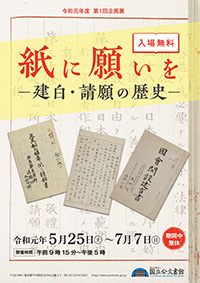 →Leaflet(PDF:1.0MB) |
Among the documents that the National Archives has in its collection are memorials such as the so-called “Tosa Memorial” of 1874 signed by Itagaki Taisuke and Etō Shinpei among others that called for the establishment of an elected national assembly and petitions as exemplified by those submitted to the government that citizens based on their right to do so as established under the Constitution of the Empire of Japan (“the Meiji Constitution”).
The present exhibition offers an overview of the changes that occurred in the system of memorials and petitions, and introduces documents of these two types that reflect the eras in which they were written to show what kinds of the hopes people of the Meiji era put to paper. |
|
[Postscript]
Thank you for reading the JACAR Newsletter No.29, and we hope you enjoyed it.
Leaflets about JACAR are available in English, Japanese, Chinese, and Korean, so if you would like copies, please contact us.
An email about the JACAR Newsletter has been sent to everyone who requested a copy as well as those who have exchanged business cards with JACAR staff members. If you do not wish to receive future e-mails, please let us know.
[Reference] TEL : +81-(0)3-5805-8801 E-MAIL : jacar_enquire@archives.go.jp


。](img/029_content01_01.jpg)
。](img/029_content01_02.jpg)
。](img/029_content01_03.jpg)
。](img/029_content01_04_01.jpg)
。](img/029_content01_04_02.jpg)
](img/029_content01_05.jpg)

